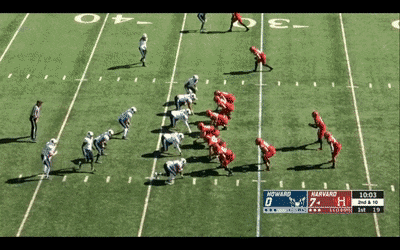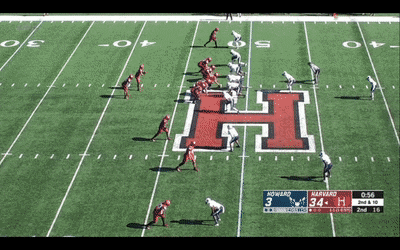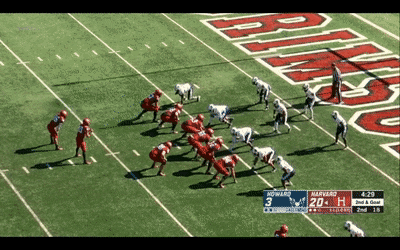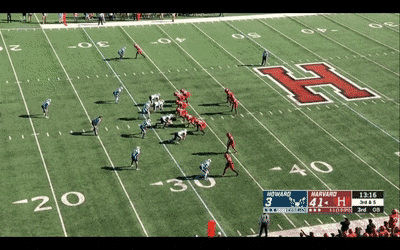Ivy Week: Harvard's Constantly Moving Offense
Harvard is using motion to create an advantage before the snap
There’s a lot that can be learned from football programs that have to work around severe talent restrictions. It’s been true for decades. More often that not, football innovation starts at the bottom, usually in high school, and then slowly moves up into the lower levels of college. Then, an FCS coach gets hired at a major school and suddenly, everyone is doing it.
It happened with the spread option, with RPOs, with just about every major change to the sport. Installing a new scheme or system requires brings with it a lot of risk and at lower level jobs, the risk is never going to be as significant, giving coaches more room to try new things. On top of that, at the lower levels of football, talent is naturally lower and working around that requires coaches to get creative.
In other words, there’s a good reason that a lot of college football’s most innovative minds came from tiny schools like New Hampshire, Fordham or, in the old days, Miami (OH).
That’s also why looking at schools that have less to work with can often serve as a way to see the future of the sport. If an FCS program is having success doing something strange, it usually means that Alabama and Ohio State are going to be running it in five years, because if a system can work with a little talent, it can usually work even better with a lot of it.
One of the best places to look for new things in recent years has been the Ivy League, partially because of the baked in disadvantage that its schools have in recruiting and partially because of the sweet deal that the league has with television networks to get a Friday night game on TV once a week. It was almost impossible to find Ivy League games prior to just a few years ago, but now that a decent amount of the product is readily available, it serves as one of the best learning resources in the sport.
Because this is a newsletter than loves and supports all levels of college football, I figured that we could afford a week off from the glitz and the glamour of major college football and take a trip to the Ivy League. Welcome to Ivy Week.
Most of the misdirection work in Harvard’s offense is done before the ball is snapped. It isn’t true of every play, but a good deal of the Crimson offense is built around pre-play motion. That isn’t entirely uncommon. Matt Canada has been doing something similar for years and managed to dismember Greg Schiano’s defense in 2018 with simple pre-play motion designed to misdirect defenders.
However, Harvard has paired the pre-play motion with a more modern offense than Canada’s and deploys some pretty nasty blocking concepts to create massive numbers advantages in both the running and passing games.

It’s really not dissimilar from what I think the next stage of football will look like at the highest level. The spread revolution is just about over and while teams aren’t going to go back under center, the rushing concepts are already starting to return to the days of grind-it-out, smashmouth football. Running 12 personnel with a pulling guard and a tight end across the middle looks modern and forward-thinking when run like this, but it’s really a return to the days of fullbacks and halfback dives.
The h-back/tight end here is serving as the proto-fullback. He’s a lead blocker following behind a pulling lineman that the running back is following. With the counter fake in the backfield, the only real difference between this and the kind of stuff that Ohio State was running in the 1970s with Archie Griffin is the formation. At its core, though, this is the same exact idea, even down to the blocking scheme. The backside guard pulls and looks to take on the play side end, who the play side tackle and tight end have ignored.
With reach blocks from the play side tackle, guard and tight end and a seal block from the backside tackle, the running back is depending heavily on his two tight ends and that guard to make a play in front of him. If the play side reach blocks do a good enough job of washing the line down, they can catch a linebacker or two in that wash as they do here, leaving two linebackers and an end for the guard and tight end pairing to block.
The guard takes the end, the tight ends take on linebackers and Harvard has a solid gain on what is basically just a classic counter, modernized to fit a more current formation.

This is how a lot of Harvard’s more base rushing attack works. The Crimson take classic concepts, like this, which is just a well-blocked inside zone, and add fancy little bells and whistles to it to make it fit a modern offense. There is a read tag on this play (look at the back side end and the quarterback), with a bubble attached on the outside, but the primary point of the play is to hand the ball off to the halfback and let him run behind a proven blocking scheme.
However, there’s no reason not to put a tag on it, especially because it’ll free up a blocker that suddenly doesn’t have to take on that defensive end and it’ll force the safety to do his job and stay in the middle of the field. So, Harvard puts a tag on it. It never hurts to have a pass tag.

Then, when you run it off of this enough, the defense is going to overcompensate and just like that, you’ve got an easy completion to the screen pass. Never hurts to have a pass tag.

Where this offense gets really cool is when it starts to bring in that aforementioned pre-play motion, which Harvard has blended into its schemes seamlessly. On most rushing plays, like this one, the motion serves entirely as a way to make things more difficult on the safeties and linebackers trying to read the backfield.
The fake handoff to a wideout in motion serves basically the same purpose as a quarterback keeper on a read option. It lets the offense isolate that end and takes the eyes of safeties and linebackers away from the backfield, even if it’s just for a split second. If the fake is executed well it can pull several defenders out of the box, as it does here. Harvard manages to take three defenders out of the box here, just by motioning a player that wasn’t going to play a role on this play anyway.
Then, with the advantage created by that motion, Harvard goes right back to that grind-it-out running game, with 12 personnel. The h-back kicks over to take on the unblocked end, freeing up the tackle to get to the second level to take on the backside linebacker. With the safeties cleared out and the third linebacker blocked on the edge by the other tight end, there’s just one more linebacker for the line to deal with. The center is free to get to the second level, takes on that linebacker and with a nice move and good vision, the halfback has a touchdown because of it.

The threat of the motion when matched with pulling action up front creates one of the more chaotic running schemes you’ll see as a linebacker in college football. There’s so much going on in the backfield and while some of it, like the motion, is just window dressing, it’s window dressing that serves a purpose. Harvard isn’t just using the motion to use it, it uses the motion to put safeties and linebackers into conflict before the play even starts. If that motion pulls just one defender away from the play and holds a second in place it has already done its job with absolutely nothing sacrificed by the offense in the process.
With the pulling action from the guard and the tight end, it’s just about hoping that those linebackers are confused enough that the pullers can seal them off. It’s not perfect here, but it’s good enough for a touchdown.

When that motion serves as a decoy enough and the defense starts to ignore it and focus on stopping the handoff to the halfback, Harvard flips the switch, gives the ball on the sweep and has an easy touchdown because of it. It’s simple, easy to block and puts you ahead of the defense on pretty much every play, because there or two or three ball carriers to worry about every time the ball is snapped. When motion is done with a purpose, it can be one of the most dangerous weapons in football.

Hell, it even works with the passing game too. It’s easy to call offenses like this gimmicky because of how much it relies on smock and mirrors to put a defense on its heels, but in football, who cares if what you’re doing is a gimmick. If it works, run it.
That’s often my favorite thing about these smaller schools. Because they don’t have the luxury of top-end talent, there’s no room to be prideful or to worry about stupid stuff like “winning the right way.” When you’re coaching a bunch of guys without recruiting rankings because they’re the only guys you can get, winning with smoke and mirrors has a whole lot more value than losing while playing like the big boys. The Ivy League is proud of weird shit like this and honestly, it should market itself even more as the league where things like this offense thrive. It’s what the American (AAC) has done at the FBS level and it’s created a really cool environment for football innovation.
If we’re lucky, a smart coach or athletic director at a major school is going to catch on to this and in 2025, the College Football Playoff will be filled with offenses that run motion on every play. For right now, though, the Ivy League is hiding a pretty cool secret.



